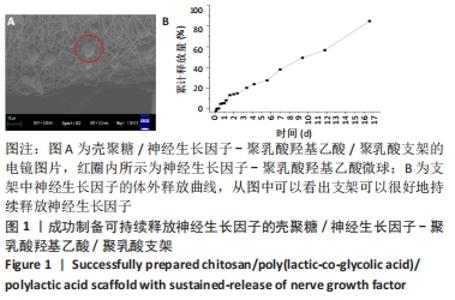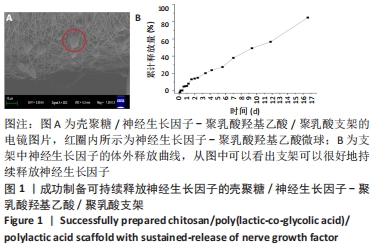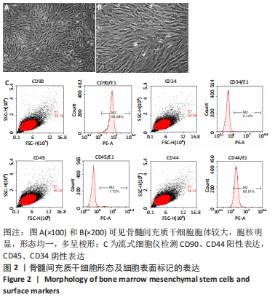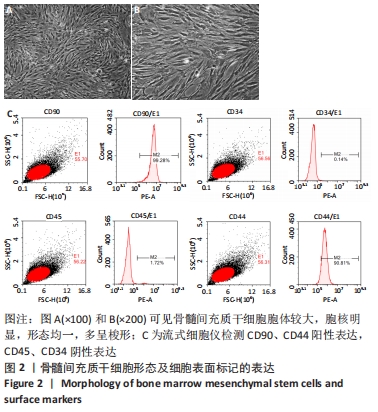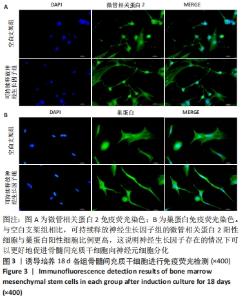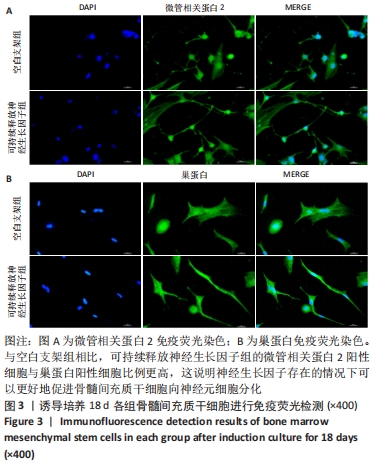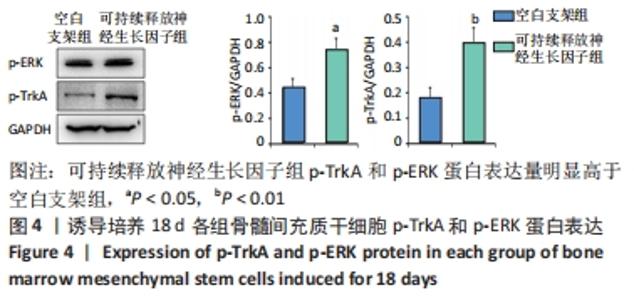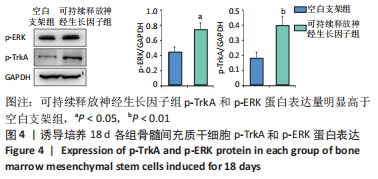Chinese Journal of Tissue Engineering Research ›› 2022, Vol. 26 ›› Issue (25): 3974-3979.doi: 10.12307/2022.401
Previous Articles Next Articles
Chitosan/poly(lactic-co-glycolic acid)/polylactic acid scaffold with sustained release of nerve growth factor promotes the differentiation of bone marrow mesenchymal stem cells into neurons
Ji Hangyu1, 2, Gu Jun2, Xie Linghan1, Bao Junping1, Peng Xin1, Wu Xiaotao1, 3
- 1School of Medicine, Southeast University, Nanjing 210009, Jiangsu Province, China; 2Department of Orthopedics, Wuxi Xishan People’s Hospital, Wuxi 214105, Jiangsu Province, China; 3Department of Orthopedics, Zhongda Hospital, Southeast University, Nanjing 210009, Jiangsu Province, China
-
Received:2020-12-29Accepted:2021-02-07Online:2022-09-08Published:2022-01-25 -
Contact:Wu Xiaotao, MD, Professor, Chief physician, Doctoral supervisor, School of Medicine, Southeast University, Nanjing 210009, Jiangsu Province, China; Department of Orthopedics, Zhongda Hospital, Southeast University, Nanjing 210009, Jiangsu Province, China -
About author:Ji Hangyu, MD, Associate chief physician, School of Medicine, Southeast University, Nanjing 210009, Jiangsu Province, China; Department of Orthopedics, Wuxi Xishan People’s Hospital, Wuxi 214105, Jiangsu Province, China Gu Jun, MD, Associate chief physician, Department of Orthopedics, Wuxi Xishan People’s Hospital, Wuxi 214105, Jiangsu Province, China Ji Hangyu and Gu Jun contributed equally to this article. -
Supported by:Clinical Medicine Technology Development Fund of Jiangsu University in 2018, No. JLY20180027 (to JHY); the General Project of Jiangsu Health Commission and Health Department Project in 2018, No. H2018023 (to GJ); the Science and Technology Demonstration Project of Social Development in Wuxi, No. N20192001 (to GJ)
CLC Number:
Cite this article
Ji Hangyu, Gu Jun, Xie Linghan, Bao Junping, Peng Xin, Wu Xiaotao. Chitosan/poly(lactic-co-glycolic acid)/polylactic acid scaffold with sustained release of nerve growth factor promotes the differentiation of bone marrow mesenchymal stem cells into neurons[J]. Chinese Journal of Tissue Engineering Research, 2022, 26(25): 3974-3979.
share this article
Add to citation manager EndNote|Reference Manager|ProCite|BibTeX|RefWorks
| [1] HOLMES D. Spinal-cord injury: spurring regrowth. Nature. 2017;552(7684): S49. [2] KIRSHBLUM S, SNIDER B, EREN F, et al. Characterizing Natural Recovery after Traumatic Spinal Cord Injury. J Neurotrauma. 2021 Jan 22. doi: 10.1089/neu.2020.7473. [3] ROWLAND JW, HAWRYLUK GW, KWON B, et al. Current status of acute spinal cord injury pathophysiology and emerging therapies: promise on the horizon. Neurosurg Focus. 2008;25(5):E2. [4] KIYOTAKE EA, MARTIN MD, DETAMORE MS. Regenerative rehabilitation with conductive biomaterials for spinal cord injury. Acta Biomater. 2020 Dec 14. doi: 10.1016/j.actbio.2020.12.021. [5] LI G, CHE MT, ZENG X, et al. Neurotrophin-3 released from implant of tissue-engineered fibroin scaffolds inhibits inflammation, enhances nerve fiber regeneration, and improves motor function in canine spinal cord injury. J Biomed Mater Res A. 2018;106(8):2158-2170. [6] ZHANG J, CHENG T, CHEN Y, et al. A chitosan-based thermosensitive scaffold loaded with bone marrow-derived mesenchymal stem cells promotes motor function recovery in spinal cord injured mice. Biomed Mater. 2020;15(3): 035020. [7] WADA N, SHIMIZU T, SHIMIZU N, et al. The effect of neutralization of nerve growth factor (NGF) on bladder and urethral dysfunction in mice with spinal cord injury. Neurourol Urodyn. 2018;37(6):1889-1896. [8] TSENG TC, TAO L, HSIEH FY, et al. An Injectable, Self-Healing Hydrogel to Repair the Central Nervous System. Adv Mater. 2015;27(23):3518-3524. [9] SONG X, XU Y, WU J, et al. A sandwich structured drug delivery composite membrane for improved recovery after spinal cord injury under longtime controlled release. Colloids Surf B Biointerfaces. 2020;199:111529. [10] LIU D, CHEN J, JIANG T, et al. Biodegradable Spheres Protect Traumatically Injured Spinal Cord by Alleviating the Glutamate-Induced Excitotoxicity. Adv Mater. 2018;30(14):e1706032. [11] LI DW, HE J, HE FL, et al. Silk fibroin/chitosan thin film promotes osteogenic and adipogenic differentiation of rat bone marrow-derived mesenchymal stem cells. J Biomater Appl. 2018;32(9):1164-1173. [12] AGARWAL S, GREINER A. On the way to clean and safe electrospinning—green electrospinning: emulsion and suspension electrospinning. Polymers for Advanced Technologies. 2011;22(3):372-378. [13] SANCHEZ-RAMOS J, SONG S, CARDOZO-PELAEZ F, et al. Adult bone marrow stromal cells differentiate into neural cells in vitro. Exp Neurol. 2000;164(2):247-256. [14] ABDULLAH RH, YASEEN NY, SALIH SM, et al. Induction of mice adult bone marrow mesenchymal stem cells into functional motor neuron-like cells. J Chem Neuroanat. 2016;77:129-142. [15] JIANG Y, HENDERSON D, BLACKSTAD M, et al. Neuroectodermal differentiation from mouse multipotent adult progenitor cells. Proc Natl Acad Sci U S A. 2003;100 Suppl 1(Suppl 1):11854-11860. [16] LEI H, ZHANG Y, HUANG L, et al. L-3-n-Butylphthalide Regulates Proliferation, Migration, and Differentiation of Neural Stem Cell In Vitro and Promotes Neurogenesis in APP/PS1 Mouse Model by Regulating BDNF/TrkB/CREB/Akt Pathway. Neurotox Res. 2018;34(3):477-488. [17] 吴俣.突触活性通过APPL1介导的TrkB内体树突逆向运输调控核内ERK/CREB信号通路的机制研究[D].杭州:浙江大学,2017. [18] HE J, HU X, CAO J, et al. Chitosan-coated hydroxyapatite and drug-loaded polytrimethylene carbonate/polylactic acid scaffold for enhancing bone regeneration. Carbohydr Polym. 2021;253:117198. [19] SAHAI N, GOGOI M, TEWARI RP. 3D printed Chitosan Composite Scaffold for Chondrocytes differentiation. Curr Med Imaging. 2020 Dec 16. doi: 10.2174/1573405616666201217112939. [20] BERNARDI S, RE F, BOSIO K, et al. Chitosan-Hydrogel Polymeric Scaffold Acts as an Independent Primary Inducer of Osteogenic Differentiation in Human Mesenchymal Stromal Cells. Materials (Basel). 2020;13(16):3546. [21] AKMEŞE R, ERTAN MB, KOCAOĞLU H. Comparison of Chitosan-Based Liquid Scaffold and Hyaluronic Acid-Based Soft Scaffold for Treatment of Talus Osteochondral Lesions. Foot Ankle Int. 2020;41(10):1240-1248. [22] LIN IC, WANG TJ, WU CL, et al. Chitosan-cartilage extracellular matrix hybrid scaffold induces chondrogenic differentiation to adipose-derived stem cells. Regen Ther. 2020;14:238-244. [23] Wu YX, Ma H, Wang JL, et al. Production of chitosan scaffolds by lyophilization or electrospinning: which is better for peripheral nerve regeneration? Neural Regen Res. 2021;16(6):1093-1098. [24] SHI S, LI F, WU L, et al. Feasibility of Bone Marrow Mesenchymal Stem Cell-Mediated Synthetic Radiosensitive Promoter-Combined Sodium Iodide Symporter for Radiogenetic Ovarian Cancer Therapy. Hum Gene Ther. 2021 Feb 22. doi: 10.1089/hum.2020.214. [25] ZHOU C, YE C, ZHAO C, et al. A Composite Tissue Engineered Bone Material Consisting of Bone Mesenchymal Stem Cells, Bone Morphogenetic Protein 9 (BMP9) Gene Lentiviral Vector, and P3HB4HB Thermogel (BMSCs-LV-BMP9-P3HB4HB) Repairs Calvarial Skull Defects in Rats by Expression of Osteogenic Factors. Med Sci Monit. 2020;26:e924666. [26] CHENG O, TIAN X, LUO Y, et al. Liver X receptors agonist promotes differentiation of rat bone marrow derived mesenchymal stem cells into dopaminergic neuron-like cells. Oncotarget. 2017;9(1):576-590. [27] YUE W, YAN F, ZHANG YL, et al. Differentiation of Rat Bone Marrow Mesenchymal Stem Cells Into Neuron-Like Cells In Vitro and Co-Cultured with Biological Scaffold as Transplantation Carrier. Med Sci Monit. 2016; 22:1766-1772. [28] KUO YC, YEH CF, YANG JT. Differentiation of bone marrow stromal cells in poly(lactide-co-glycolide)/chitosan scaffolds. Biomaterials. 2009;30(34): 6604-6613. [29] 程蓉,钱欣.聚乳酸的改性及应用进展[J].化工进展,2002,21(11):824-826. [30] 曹燕琳,尹静波,颜世峰.生物可降解聚乳酸的改性及其应用研究进展[J].高分子通报,2006,84(10):90-97. [31] 徐丽丽,匡弢,张佳.体外诱导骨髓间充质干细胞向神经元样细胞分化:两种方法的比较[J].中国组织工程研究,2013,17(45):7821-7826. [32] JIN K, MAO XO, BATTEUR S, et al. Induction of neuronal markers in bone marrow cells: differential effects of growth factors and patterns of intracellular expression. Exp Neurol. 2003;184(1):78-89. [33] CHEN J, LI Y, WANG L, et al. Therapeutic benefit of intracerebral transplantation of bone marrow stromal cells after cerebral ischemia in rats. J Neurol Sci. 2001;189(1-2):49-57. [34] MAHMOOD A, LU D, YI L, et al. Intracranial bone marrow transplantation after traumatic brain injury improving functional outcome in adult rats. J Neurosurg. 2001;94(4):589-595. [35] ZHANG J, LU X, FENG G, et al. Chitosan scaffolds induce human dental pulp stem cells to neural differentiation: potential roles for spinal cord injury therapy. Cell Tissue Res. 2016;366(1):129-142. [36] LIU H, PENG H, WU Y, et al. The promotion of bone regeneration by nanofibrous hydroxyapatite/chitosan scaffolds by effects on integrin-BMP/Smad signaling pathway in BMSCs. Biomaterials. 2013;34(18):4404-4417. [37] FENG Z, LI K, LIU M, et al. NRAGE is a negative regulator of nerve growth factor-stimulated neurite outgrowth in PC12 cells mediated through TrkA-ERK signaling. J Neurosci Res. 2010;88(8):1822-1828. [38] AVERILL S, MCMAHON SB, CLARY DO, et al. Immunocytochemical localization of trkA receptors in chemically identified subgroups of adult rat sensory neurons. Eur J Neurosci. 1995;7(7):1484-1494. [39] INDO Y, TSURUTA M, HAYASHIDA Y, et al. Mutations in the TRKA/NGF receptor gene in patients with congenital insensitivity to pain with anhidrosis. Nat Genet. 1996;13(4):485-488. [40] IANNONE F, DE BARI C, DELL’ACCIO F, et al. Increased expression of nerve growth factor (NGF) and high affinity NGF receptor (p140 TrkA) in human osteoarthritic chondrocytes. Rheumatology (Oxford). 2002;41(12):1413-1418. [41] YUAN J, HUANG G, XIAO Z, et al. Overexpression of β-NGF promotes differentiation of bone marrow mesenchymal stem cells into neurons through regulation of AKT and MAPK pathway. Mol Cell Biochem. 2013; 383(1-2):201-211. |
| [1] | Xiao Yang, Gong Liqiong, Fei Jing, Li Leiji. Effect of electroacupuncture on nerve growth factor and its receptor expression in facial nerve nucleus after facial nerve injury in rabbits [J]. Chinese Journal of Tissue Engineering Research, 2022, 26(8): 1253-1259. |
| [2] | Wang Jing, Xiong Shan, Cao Jin, Feng Linwei, Wang Xin. Role and mechanism of interleukin-3 in bone metabolism [J]. Chinese Journal of Tissue Engineering Research, 2022, 26(8): 1260-1265. |
| [3] | Xiao Hao, Liu Jing, Zhou Jun. Research progress of pulsed electromagnetic field in the treatment of postmenopausal osteoporosis [J]. Chinese Journal of Tissue Engineering Research, 2022, 26(8): 1266-1271. |
| [4] | Wen Dandan, Li Qiang, Shen Caiqi, Ji Zhe, Jin Peisheng. Nocardia rubra cell wall skeleton for extemal use improves the viability of adipogenic mesenchymal stem cells and promotes diabetes wound repair [J]. Chinese Journal of Tissue Engineering Research, 2022, 26(7): 1038-1044. |
| [5] | Zhu Bingbing, Deng Jianghua, Chen Jingjing, Mu Xiaoling. Interleukin-8 receptor enhances the migration and adhesion of umbilical cord mesenchymal stem cells to injured endothelium [J]. Chinese Journal of Tissue Engineering Research, 2022, 26(7): 1045-1050. |
| [6] | Luo Xiaoling, Zhang Li, Yang Maohua, Xu Jie, Xu Xiaomei. Effect of naringenin on osteogenic differentiation of human periodontal ligament stem cells [J]. Chinese Journal of Tissue Engineering Research, 2022, 26(7): 1051-1056. |
| [7] | Wen Xiaoyu, Sun Yuhao, Xia Meng. Effects of serum containing Wuzang Wenyang Huayu Decoction on phosphorylated-tau protein expression in Alzheimer’s disease cell model [J]. Chinese Journal of Tissue Engineering Research, 2022, 26(7): 1068-1073. |
| [8] | Wang Xinmin, Liu Fei, Xu Jie, Bai Yuxi, Lü Jian. Core decompression combined with dental pulp stem cells in the treatment of steroid-associated femoral head necrosis in rabbits [J]. Chinese Journal of Tissue Engineering Research, 2022, 26(7): 1074-1079. |
| [9] | Fang Xiaolei, Leng Jun, Zhang Chen, Liu Huimin, Guo Wen. Systematic evaluation of different therapeutic effects of mesenchymal stem cell transplantation in the treatment of ischemic stroke [J]. Chinese Journal of Tissue Engineering Research, 2022, 26(7): 1085-1092. |
| [10] | Guo Jia, Ding Qionghua, Liu Ze, Lü Siyi, Zhou Quancheng, Gao Yuhua, Bai Chunyu. Biological characteristics and immunoregulation of exosomes derived from mesenchymal stem cells [J]. Chinese Journal of Tissue Engineering Research, 2022, 26(7): 1093-1101. |
| [11] | Huang Chenwei, Fei Yankang, Zhu Mengmei, Li Penghao, Yu Bing. Important role of glutathione in stemness and regulation of stem cells [J]. Chinese Journal of Tissue Engineering Research, 2022, 26(7): 1119-1124. |
| [12] | Hui Xiaoshan, Bai Jing, Zhou Siyuan, Wang Jie, Zhang Jinsheng, He Qingyong, Meng Peipei. Theoretical mechanism of traditional Chinese medicine theory on stem cell induced differentiation [J]. Chinese Journal of Tissue Engineering Research, 2022, 26(7): 1125-1129. |
| [13] | An Weizheng, He Xiao, Ren Shuai, Liu Jianyu. Potential of muscle-derived stem cells in peripheral nerve regeneration [J]. Chinese Journal of Tissue Engineering Research, 2022, 26(7): 1130-1136. |
| [14] | Fan Yiming, Liu Fangyu, Zhang Hongyu, Li Shuai, Wang Yansong. Serial questions about endogenous neural stem cell response in the ependymal zone after spinal cord injury [J]. Chinese Journal of Tissue Engineering Research, 2022, 26(7): 1137-1142. |
| [15] | Tian Chuan, Zhu Xiangqing, Yang Zailing, Yan Donghai, Li Ye, Wang Yanying, Yang Yukun, He Jie, Lü Guanke, Cai Xuemin, Shu Liping, He Zhixu, Pan Xinghua. Bone marrow mesenchymal stem cells regulate ovarian aging in macaques [J]. Chinese Journal of Tissue Engineering Research, 2022, 26(7): 985-991. |
| Viewed | ||||||
|
Full text |
|
|||||
|
Abstract |
|
|||||
